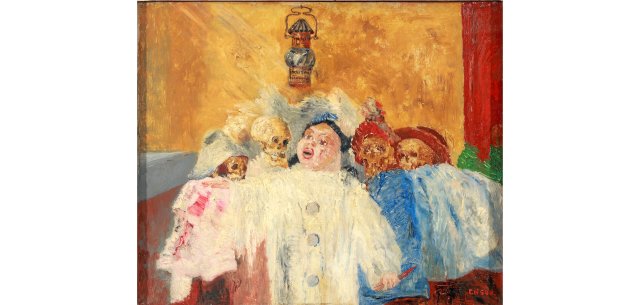The mixture of delicate pastels and rich primary colors is characteristic of Ensor’s work: “Pierrot and Skeletons”, oil on canvas, 1905
Photo: Collection KBC Bank NV, Brussels
Two double exhibitions are currently on view in Brussels: The Bozar and the Royal Museums are dedicated to Surrealism, which emerged around 100 years ago, and the work of James Ensor, which played a key role in the development of art, is also on display in the Bozar and the Royal Library of Belgium Surrealism contributed. The reason for the latter exhibitions is the anniversary of Ensor’s death on November 19, 1949, which will be 75 years old this year. Ensor only found his great institutional recognition late in life, but was then even made a baron by the Belgian king – even though his art once showed a strong socialist influence. Today he is one of Belgium’s most famous artists.
Born in Ostend in 1860, Ensor had a groundbreaking creative period in his years in Brussels, where he began studying in 1877, according to the exhibition “Ensor inspired by Brussels” in the Royal Library. The library has exhibition rooms attached to it in the former Museum of Modern Art in the palace of Charles of Lorraine: Ensor had already exhibited controversial paintings in these rooms in 1887. The partly interactive show shows 75 works, mainly from his student and early creative years, such as nude studies, charcoal drawings, etchings and engravings. But also the painting “The Lamp Boy” from 1880: a work in a realistic style in which a lamp boy lights the city lanterns at night. It was purchased by the Belgian Museum of Fine Arts shortly after its completion and marks the first recognition of Ensor’s talent.
The exhibition with the impressive title “Maestro” in the Bozar Museum shows right at the beginning the picture “The Entry of Christ into Brussels” (1888/89): a sore point in Belgian cultural policy, because the original was acquired from inherited private property at the end of the 1980s sold to the Getty Museum in Los Angeles. Here, too, Ensor’s real magnum opus is not to be seen. The reproduction on display is not an oil painting like that one, but a knotted tapestry. Jesus rides into the city of Brussels on a horse with the face of Ensor. It is a political picture that brings together many of Ensor’s styles. Above the cheering crowd, a banner that dominates the image reads “Vive la Social,” a popular slogan among socialists of the time.
The biblical is an important part of Ensor’s work. The motifs become modern because the artist frees them from their religious meaning and begins to interpret them symbolistically. Trained by the old masters such as Rembrandt, Ensor makes Jesus a symbol of light and in some pictures identifies himself with the bringer of salvation. At the same time, he tries to pass himself off as a revolutionary, as other works on display also bear witness to.
In the crowd of people that can be seen in “The Entry of Christ into Brussels,” no two faces are alike. Many are covered by masks, a favorite motif of the artist. Because Belgium was and is a very Catholic country and carnival customs play a big role. Festivals as a whole fascinated Ensor. It is surprising to discover that he also composed pieces of music. In the exhibition you can hear his music for the ballet “La Gamme d’Amour” and view the drawings for the performance. It is precisely these colorful drawings in a mixture of pastel colors and rich primary colors that make Ensor very contemporary in purely aesthetic terms.
In an interview shown in the exhibition, the artist enthuses into the camera: “I love painting beautiful words.” This is what makes him so influential for Belgian Surrealism, which explored the special connection between word and image. Nevertheless, in an exhibition review in 1945, René Magritte wrote about James Ensor: “The themes are indifferent (…). It is clear that this does not represent a new way of understanding the world, as did Millet, Courbet or Manet. James Ensor’s work was characterized by euphoria without foresight and a good-natured humor. It represents quite well the idea of the happiness that the bourgeoisie could make around 1900 (…) Poor and brave James Ensor! You have been made a baron and the pictures in which you celebrated your youth have now become sad objects of speculation. The exhibition review appeared in the magazine of the Belgian Communist Party, Le Drapeau Rouge. The commercial success that Magritte mocks is a fate that would also befall him.
The film shows Ensor at almost 90 years old in Ostend after the war. At that time he was still considered a bizarre artistic figure, a painter of the uncanny who also broke with convention through his solitary lifestyle. His house in Ostend is now a museum and his life, like his work, fascinates with the mixture of reality and fantasy. The two Brussels exhibitions are worth seeing – even if the presentation of Ensor’s political beliefs falls short overall.
“Ensor inspired by Brussels”, until June 2nd, Royal Library of Belgium, and “James Ensor. Maestro”, until June 23rd, Bozar, Brussels
Subscribe to the “nd”

Being left is complicated.
We keep track!
With our digital promotional subscription you can read all issues of »nd« digitally (nd.App or nd.Epaper) for little money at home or on the go.
Subscribe now!
judi bola online pragmatic play sbobet sbobet88
